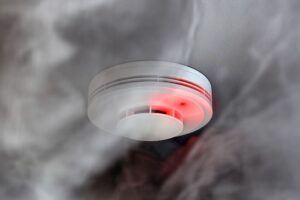Toxic Gas Detection Systems in Phoenix, AZ
The Best Hazardous Gas Detection Service in AZ
Ensuring the safety of your workplace against toxic gas threats is paramount, and at Service 1st Fire Protection LLC, we offer unparalleled toxic gas detection services in Phoenix, AZ. Don’t leave the well-being of your workforce to chance; take proactive steps today by scheduling a consultation with our experts.
Types of Toxic Gas Detection Systems
Toxic gas detection systems come in various forms to suit diverse needs. Fixed systems are permanently installed in specific locations, continuously monitoring hazardous gases for constant protection in critical areas. Portable detectors offer flexibility, allowing personnel to carry them for spot checks and confined spaces. Advancements include wireless and IoT-enabled solutions, enabling real-time remote monitoring and enhancing safety insights through data analysis and predictive maintenance. Combining fixed, portable, and wireless detectors provides a comprehensive approach to safeguard against toxic gas threats in various settings.
Technologies Used in Toxic Gas Detectors
Toxic gas detectors use sophisticated technologies for accurate monitoring. These include electrochemical sensors, which rely on chemical reactions for electrical signals; semiconductor sensors, which detect gas through electrical resistance changes; and infrared sensors, which measure infrared radiation absorption for high sensitivity. Additional options like ultrasonic and catalytic bead sensors are used for specific gases. Advancements in microelectronics enable smart features like wireless connectivity and data logging, enhancing functionality. These cutting-edge technologies ensure reliable and rapid detection, promoting safety in various settings.
Selecting the Right Toxic Gas Detection System
Choosing the right toxic gas detection system is vital for safety. Consider gas types, detection range, and application. Evaluate sensitivity, accuracy, response time, and compatibility with safety protocols. Check maintenance and calibration requirements for reliability. Look for data logging, remote monitoring, and alarm features. Seek expert guidance for a tailored solution, whether fixed, portable, or wireless. Prioritize quality and adaptability for your facility’s needs.
Toxic Gas Detection Installation and Maintenance
Toxic gas detection installation and maintenance are essential for system effectiveness. Carefully consider location, environmental factors, and gas sources during installation. Regular maintenance ensures accuracy, including sensor checks, calibration, and software updates. Trained technicians should promptly address issues to prevent false alarms or compromised detection. A well-maintained system provides early warnings and enables timely safety measures.
Benefits of Investing in a Toxic Gas Detection System
Toxic gas detection systems are critical in safeguarding lives and properties from potential hazards. Toxic gas detection sensors help promote workplace safety, help provide regulatory compliance, and environmental protection. The benefits include:
- Early Warning – Poison gas detectors offer early detection of hazardous gases, enabling timely evacuation and prompt response to prevent potential accidents or health risks.
- Enhanced Safety – By continuously monitoring the environment for toxic gases, these systems create a safer work environment, reducing the risk of exposure to harmful substances.
- Environmental Protection – Fire and gas detection systems can prevent the release of harmful gases into the environment, reducing the risk of pollution and ecological damage.
- Regulatory Compliance – Many industries are required to have toxic gas detection systems in place to comply with safety regulations and ensure workplace safety standards.
- Remote Monitoring – Advanced toxic gas detection systems offer remote monitoring capabilities, enabling real-time data access and swift response to potential threats, even from off-site locations.
FAQs
What are the most common toxic gases found in industrial settings?
The most common toxic gases found in industrial settings include carbon monoxide (CO), hydrogen sulfide (H2S), ammonia (NH3), chlorine (Cl2), sulfur dioxide (SO2), and nitrogen dioxide (NO2). These gases can pose serious health risks to workers if not detected and monitored properly.
How do toxic gas detectors work?
Toxic gas detectors use various sensing technologies, including electrochemical sensors (chemical reactions generating electrical signals), infrared sensors (measuring gas absorption), and semiconductor sensors (detecting electrical resistance changes). When the gas concentration exceeds a threshold, detectors trigger alarms for potential hazard warnings.
How often should gas detectors be calibrated?
Gas detectors should be calibrated regularly based on sensor type, manufacturer’s recommendations, and industry regulations. Calibration frequencies typically range from monthly to annually. Frequent testing in harsh conditions or after exposure to extreme environments ensures accurate and reliable performance, reducing false alarms and detecting gas leaks effectively. Proper calibration is crucial for accurate readings and maintaining detector performance.
Contact Us for Toxic Gas Detection Solutions
Don’t compromise on workplace safety. Protect your business with our advanced toxic gas detection solutions with Service 1st Fire Protection LLC. Schedule a consultation now. You can also explore our other services for all your fire protection needs.
Why Choose Us?
- Competitive Pricing
- 24/7 Emergency Service Available
- Quality Personal Client Service
